Security of Payment Act (NSW): Building Law Report
VerifiedAdded on 2023/01/05
|9
|2500
|57
Report
AI Summary
This report provides a detailed analysis of the Building and Construction Industry Security of Payment Act (NSW) of 1999. It explores the Act's functions, including its role in ensuring timely payments to contractors and subcontractors within the construction industry, and its mechanisms for resolving payment disputes through adjudication. The report examines the Act's introduction, highlighting the need to address unfair payment practices and protect subcontractors from financial hardship. It also discusses how the Act works in relation to regular court actions and outlines the amendments made in 2013 to enhance subcontractors' rights. Furthermore, the report explains the adjudication process, the role of Authorized Nominating Authorities (ANAs), and the enforcement of adjudicator's determinations, including the registration of judgments. The report underscores the Act's significance in reforming payment behavior within the construction industry, providing a fair and efficient framework for resolving payment-related issues.
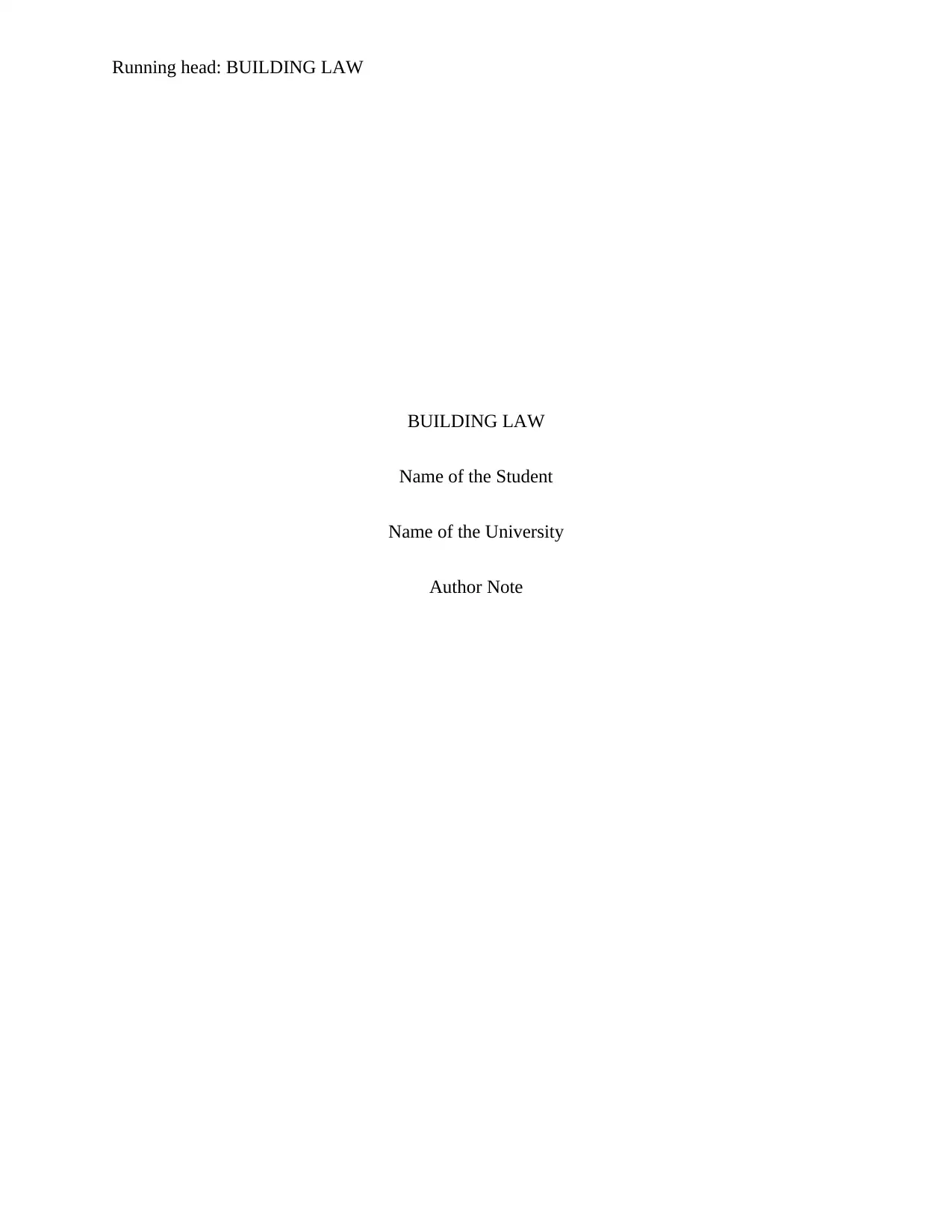
Running head: BUILDING LAW
BUILDING LAW
Name of the Student
Name of the University
Author Note
BUILDING LAW
Name of the Student
Name of the University
Author Note
Paraphrase This Document
Need a fresh take? Get an instant paraphrase of this document with our AI Paraphraser

1BUILDING LAW
1) How does the Act work?
The state of New South Wales is regarded as the first jurisdiction of the nation of
Australia to be responsible for the introduction of the legislation named ‘security of payment’.
The nature of this particular legislation is explicitly in relation to the industries. To be specific,
this particular legislation is in relation to the industry of building and construction. The Building
and Construction Industry Security of Payment Act (NSW) of the year 1999 [the Act of NSW],
was approved to on the 5th day of the month of October in the year of 1999. The Act of NSW
initiated on the twenty sixth day of the month of March in the year of 2000. Presently, every
territories and the states of the country of Australia has instigated similar legislations in relation
to the industry of construction and building. Except two jurisdictions of the nation, every other
jurisdictions of the country have adopted the legislation of security of payment on the basis of
the Act of NSW1.
The words ‘security of payment’ may be referred to the fact that the suppliers, the
consultants, the contractors and the sub-contractors in relation to the contractual chain shall be
entitled to receive the payments that may be due from any party who holds a higher position in
the chain, according to the terms of any particular contract. The primary issue in relation to the
‘security of payment’ regarding the construction and the building industry may be said to be the
continuous failure to make sure that the parties in a particular contract are provided with proper
and complete payment in relation to their work or job. These payments must be made to the
required parties within a specified time period, and such timely payments are also among the
failed cases in this regard. Such problems arise in the construction and the building industry,
1 Ashworth, Allan, and Srinath Perera. Contractual procedures in the construction industry. Routledge, 2018.
1) How does the Act work?
The state of New South Wales is regarded as the first jurisdiction of the nation of
Australia to be responsible for the introduction of the legislation named ‘security of payment’.
The nature of this particular legislation is explicitly in relation to the industries. To be specific,
this particular legislation is in relation to the industry of building and construction. The Building
and Construction Industry Security of Payment Act (NSW) of the year 1999 [the Act of NSW],
was approved to on the 5th day of the month of October in the year of 1999. The Act of NSW
initiated on the twenty sixth day of the month of March in the year of 2000. Presently, every
territories and the states of the country of Australia has instigated similar legislations in relation
to the industry of construction and building. Except two jurisdictions of the nation, every other
jurisdictions of the country have adopted the legislation of security of payment on the basis of
the Act of NSW1.
The words ‘security of payment’ may be referred to the fact that the suppliers, the
consultants, the contractors and the sub-contractors in relation to the contractual chain shall be
entitled to receive the payments that may be due from any party who holds a higher position in
the chain, according to the terms of any particular contract. The primary issue in relation to the
‘security of payment’ regarding the construction and the building industry may be said to be the
continuous failure to make sure that the parties in a particular contract are provided with proper
and complete payment in relation to their work or job. These payments must be made to the
required parties within a specified time period, and such timely payments are also among the
failed cases in this regard. Such problems arise in the construction and the building industry,
1 Ashworth, Allan, and Srinath Perera. Contractual procedures in the construction industry. Routledge, 2018.
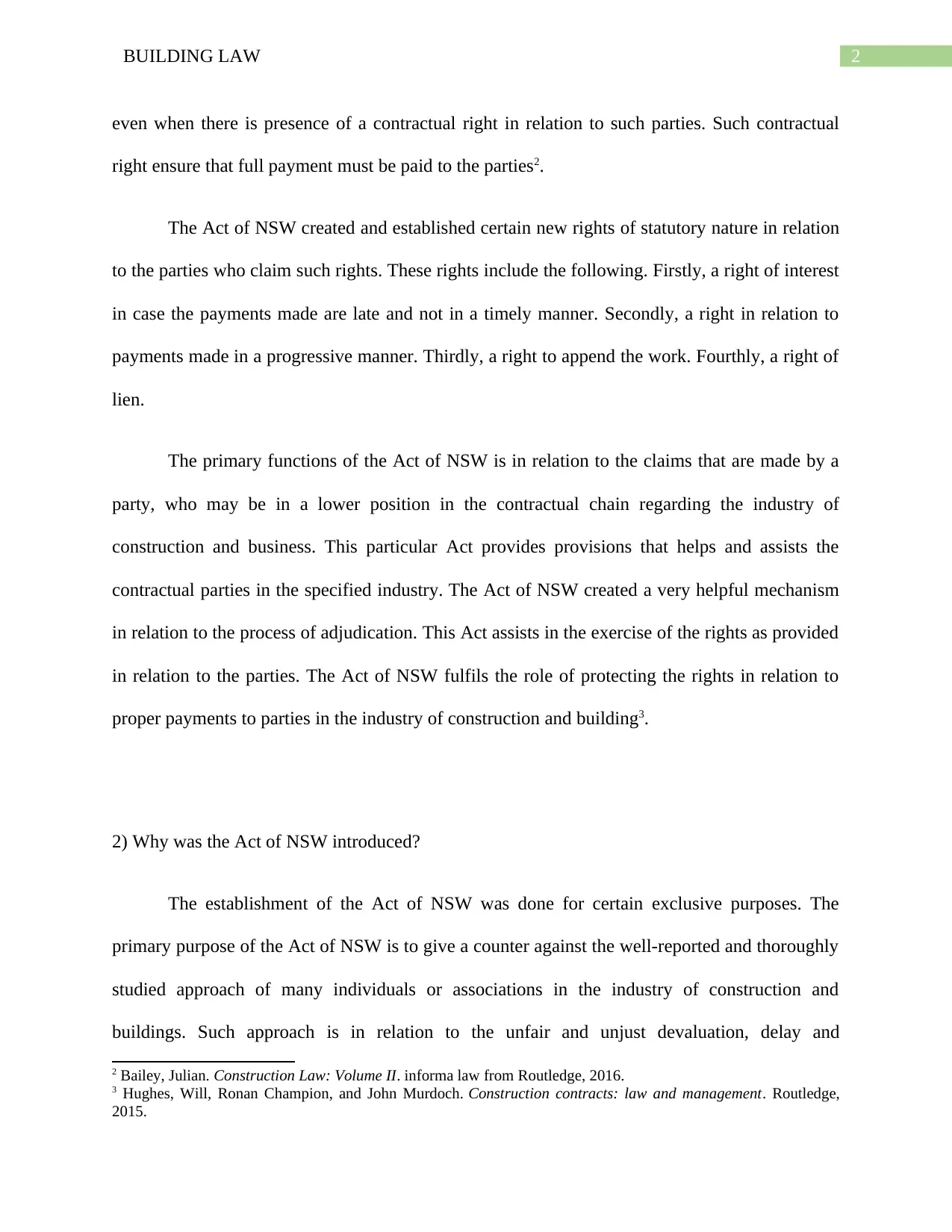
2BUILDING LAW
even when there is presence of a contractual right in relation to such parties. Such contractual
right ensure that full payment must be paid to the parties2.
The Act of NSW created and established certain new rights of statutory nature in relation
to the parties who claim such rights. These rights include the following. Firstly, a right of interest
in case the payments made are late and not in a timely manner. Secondly, a right in relation to
payments made in a progressive manner. Thirdly, a right to append the work. Fourthly, a right of
lien.
The primary functions of the Act of NSW is in relation to the claims that are made by a
party, who may be in a lower position in the contractual chain regarding the industry of
construction and business. This particular Act provides provisions that helps and assists the
contractual parties in the specified industry. The Act of NSW created a very helpful mechanism
in relation to the process of adjudication. This Act assists in the exercise of the rights as provided
in relation to the parties. The Act of NSW fulfils the role of protecting the rights in relation to
proper payments to parties in the industry of construction and building3.
2) Why was the Act of NSW introduced?
The establishment of the Act of NSW was done for certain exclusive purposes. The
primary purpose of the Act of NSW is to give a counter against the well-reported and thoroughly
studied approach of many individuals or associations in the industry of construction and
buildings. Such approach is in relation to the unfair and unjust devaluation, delay and
2 Bailey, Julian. Construction Law: Volume II. informa law from Routledge, 2016.
3 Hughes, Will, Ronan Champion, and John Murdoch. Construction contracts: law and management. Routledge,
2015.
even when there is presence of a contractual right in relation to such parties. Such contractual
right ensure that full payment must be paid to the parties2.
The Act of NSW created and established certain new rights of statutory nature in relation
to the parties who claim such rights. These rights include the following. Firstly, a right of interest
in case the payments made are late and not in a timely manner. Secondly, a right in relation to
payments made in a progressive manner. Thirdly, a right to append the work. Fourthly, a right of
lien.
The primary functions of the Act of NSW is in relation to the claims that are made by a
party, who may be in a lower position in the contractual chain regarding the industry of
construction and business. This particular Act provides provisions that helps and assists the
contractual parties in the specified industry. The Act of NSW created a very helpful mechanism
in relation to the process of adjudication. This Act assists in the exercise of the rights as provided
in relation to the parties. The Act of NSW fulfils the role of protecting the rights in relation to
proper payments to parties in the industry of construction and building3.
2) Why was the Act of NSW introduced?
The establishment of the Act of NSW was done for certain exclusive purposes. The
primary purpose of the Act of NSW is to give a counter against the well-reported and thoroughly
studied approach of many individuals or associations in the industry of construction and
buildings. Such approach is in relation to the unfair and unjust devaluation, delay and
2 Bailey, Julian. Construction Law: Volume II. informa law from Routledge, 2016.
3 Hughes, Will, Ronan Champion, and John Murdoch. Construction contracts: law and management. Routledge,
2015.
⊘ This is a preview!⊘
Do you want full access?
Subscribe today to unlock all pages.

Trusted by 1+ million students worldwide
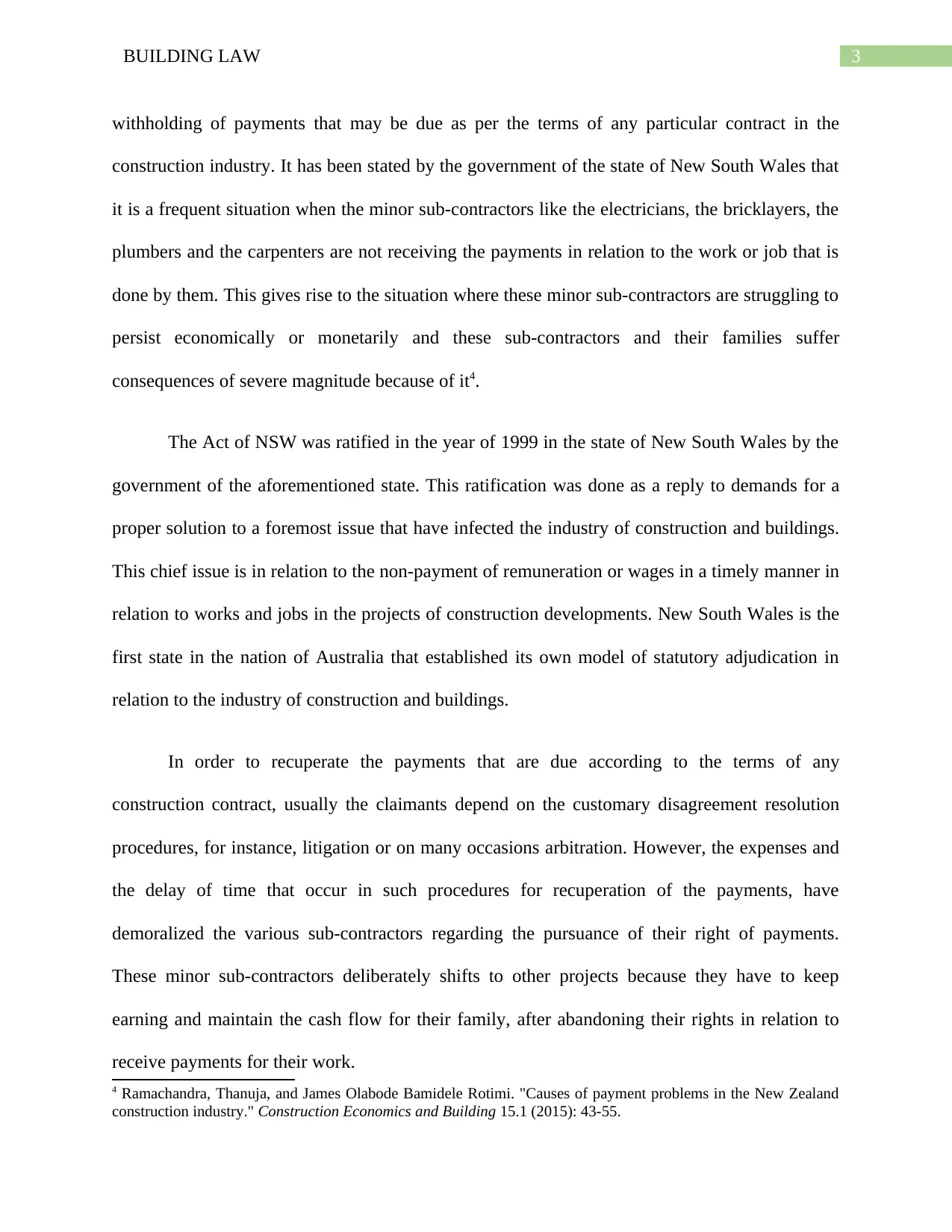
3BUILDING LAW
withholding of payments that may be due as per the terms of any particular contract in the
construction industry. It has been stated by the government of the state of New South Wales that
it is a frequent situation when the minor sub-contractors like the electricians, the bricklayers, the
plumbers and the carpenters are not receiving the payments in relation to the work or job that is
done by them. This gives rise to the situation where these minor sub-contractors are struggling to
persist economically or monetarily and these sub-contractors and their families suffer
consequences of severe magnitude because of it4.
The Act of NSW was ratified in the year of 1999 in the state of New South Wales by the
government of the aforementioned state. This ratification was done as a reply to demands for a
proper solution to a foremost issue that have infected the industry of construction and buildings.
This chief issue is in relation to the non-payment of remuneration or wages in a timely manner in
relation to works and jobs in the projects of construction developments. New South Wales is the
first state in the nation of Australia that established its own model of statutory adjudication in
relation to the industry of construction and buildings.
In order to recuperate the payments that are due according to the terms of any
construction contract, usually the claimants depend on the customary disagreement resolution
procedures, for instance, litigation or on many occasions arbitration. However, the expenses and
the delay of time that occur in such procedures for recuperation of the payments, have
demoralized the various sub-contractors regarding the pursuance of their right of payments.
These minor sub-contractors deliberately shifts to other projects because they have to keep
earning and maintain the cash flow for their family, after abandoning their rights in relation to
receive payments for their work.
4 Ramachandra, Thanuja, and James Olabode Bamidele Rotimi. "Causes of payment problems in the New Zealand
construction industry." Construction Economics and Building 15.1 (2015): 43-55.
withholding of payments that may be due as per the terms of any particular contract in the
construction industry. It has been stated by the government of the state of New South Wales that
it is a frequent situation when the minor sub-contractors like the electricians, the bricklayers, the
plumbers and the carpenters are not receiving the payments in relation to the work or job that is
done by them. This gives rise to the situation where these minor sub-contractors are struggling to
persist economically or monetarily and these sub-contractors and their families suffer
consequences of severe magnitude because of it4.
The Act of NSW was ratified in the year of 1999 in the state of New South Wales by the
government of the aforementioned state. This ratification was done as a reply to demands for a
proper solution to a foremost issue that have infected the industry of construction and buildings.
This chief issue is in relation to the non-payment of remuneration or wages in a timely manner in
relation to works and jobs in the projects of construction developments. New South Wales is the
first state in the nation of Australia that established its own model of statutory adjudication in
relation to the industry of construction and buildings.
In order to recuperate the payments that are due according to the terms of any
construction contract, usually the claimants depend on the customary disagreement resolution
procedures, for instance, litigation or on many occasions arbitration. However, the expenses and
the delay of time that occur in such procedures for recuperation of the payments, have
demoralized the various sub-contractors regarding the pursuance of their right of payments.
These minor sub-contractors deliberately shifts to other projects because they have to keep
earning and maintain the cash flow for their family, after abandoning their rights in relation to
receive payments for their work.
4 Ramachandra, Thanuja, and James Olabode Bamidele Rotimi. "Causes of payment problems in the New Zealand
construction industry." Construction Economics and Building 15.1 (2015): 43-55.
Paraphrase This Document
Need a fresh take? Get an instant paraphrase of this document with our AI Paraphraser
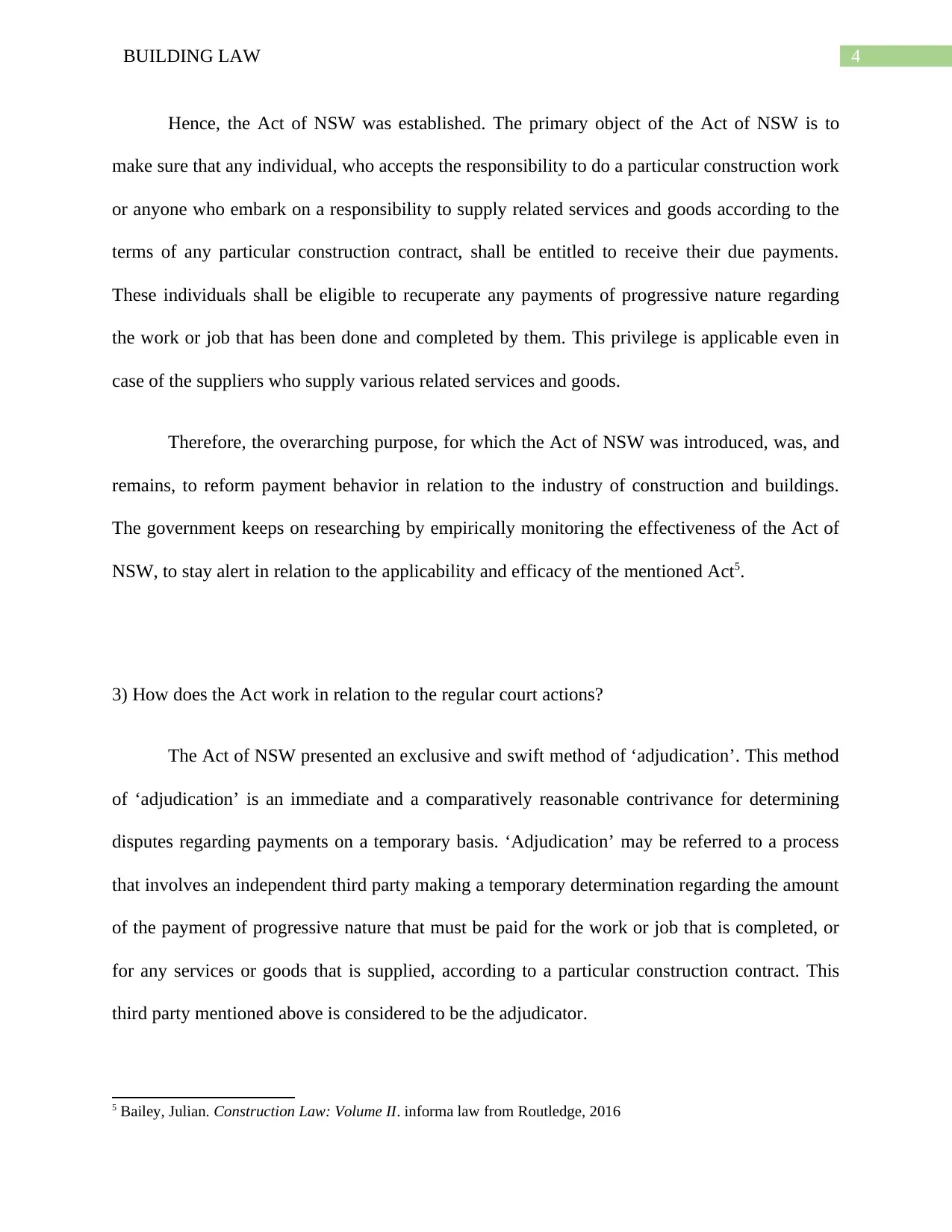
4BUILDING LAW
Hence, the Act of NSW was established. The primary object of the Act of NSW is to
make sure that any individual, who accepts the responsibility to do a particular construction work
or anyone who embark on a responsibility to supply related services and goods according to the
terms of any particular construction contract, shall be entitled to receive their due payments.
These individuals shall be eligible to recuperate any payments of progressive nature regarding
the work or job that has been done and completed by them. This privilege is applicable even in
case of the suppliers who supply various related services and goods.
Therefore, the overarching purpose, for which the Act of NSW was introduced, was, and
remains, to reform payment behavior in relation to the industry of construction and buildings.
The government keeps on researching by empirically monitoring the effectiveness of the Act of
NSW, to stay alert in relation to the applicability and efficacy of the mentioned Act5.
3) How does the Act work in relation to the regular court actions?
The Act of NSW presented an exclusive and swift method of ‘adjudication’. This method
of ‘adjudication’ is an immediate and a comparatively reasonable contrivance for determining
disputes regarding payments on a temporary basis. ‘Adjudication’ may be referred to a process
that involves an independent third party making a temporary determination regarding the amount
of the payment of progressive nature that must be paid for the work or job that is completed, or
for any services or goods that is supplied, according to a particular construction contract. This
third party mentioned above is considered to be the adjudicator.
5 Bailey, Julian. Construction Law: Volume II. informa law from Routledge, 2016
Hence, the Act of NSW was established. The primary object of the Act of NSW is to
make sure that any individual, who accepts the responsibility to do a particular construction work
or anyone who embark on a responsibility to supply related services and goods according to the
terms of any particular construction contract, shall be entitled to receive their due payments.
These individuals shall be eligible to recuperate any payments of progressive nature regarding
the work or job that has been done and completed by them. This privilege is applicable even in
case of the suppliers who supply various related services and goods.
Therefore, the overarching purpose, for which the Act of NSW was introduced, was, and
remains, to reform payment behavior in relation to the industry of construction and buildings.
The government keeps on researching by empirically monitoring the effectiveness of the Act of
NSW, to stay alert in relation to the applicability and efficacy of the mentioned Act5.
3) How does the Act work in relation to the regular court actions?
The Act of NSW presented an exclusive and swift method of ‘adjudication’. This method
of ‘adjudication’ is an immediate and a comparatively reasonable contrivance for determining
disputes regarding payments on a temporary basis. ‘Adjudication’ may be referred to a process
that involves an independent third party making a temporary determination regarding the amount
of the payment of progressive nature that must be paid for the work or job that is completed, or
for any services or goods that is supplied, according to a particular construction contract. This
third party mentioned above is considered to be the adjudicator.
5 Bailey, Julian. Construction Law: Volume II. informa law from Routledge, 2016
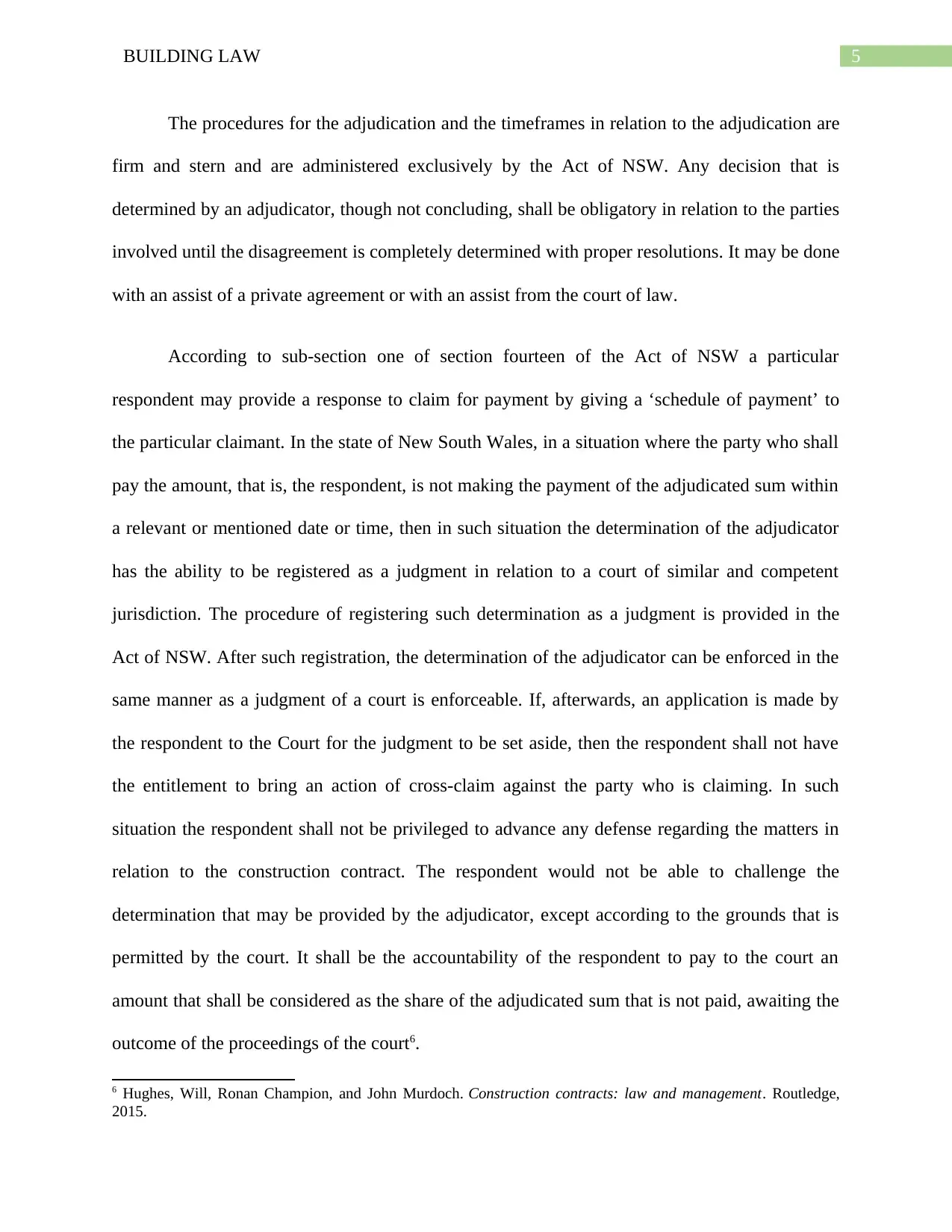
5BUILDING LAW
The procedures for the adjudication and the timeframes in relation to the adjudication are
firm and stern and are administered exclusively by the Act of NSW. Any decision that is
determined by an adjudicator, though not concluding, shall be obligatory in relation to the parties
involved until the disagreement is completely determined with proper resolutions. It may be done
with an assist of a private agreement or with an assist from the court of law.
According to sub-section one of section fourteen of the Act of NSW a particular
respondent may provide a response to claim for payment by giving a ‘schedule of payment’ to
the particular claimant. In the state of New South Wales, in a situation where the party who shall
pay the amount, that is, the respondent, is not making the payment of the adjudicated sum within
a relevant or mentioned date or time, then in such situation the determination of the adjudicator
has the ability to be registered as a judgment in relation to a court of similar and competent
jurisdiction. The procedure of registering such determination as a judgment is provided in the
Act of NSW. After such registration, the determination of the adjudicator can be enforced in the
same manner as a judgment of a court is enforceable. If, afterwards, an application is made by
the respondent to the Court for the judgment to be set aside, then the respondent shall not have
the entitlement to bring an action of cross-claim against the party who is claiming. In such
situation the respondent shall not be privileged to advance any defense regarding the matters in
relation to the construction contract. The respondent would not be able to challenge the
determination that may be provided by the adjudicator, except according to the grounds that is
permitted by the court. It shall be the accountability of the respondent to pay to the court an
amount that shall be considered as the share of the adjudicated sum that is not paid, awaiting the
outcome of the proceedings of the court6.
6 Hughes, Will, Ronan Champion, and John Murdoch. Construction contracts: law and management. Routledge,
2015.
The procedures for the adjudication and the timeframes in relation to the adjudication are
firm and stern and are administered exclusively by the Act of NSW. Any decision that is
determined by an adjudicator, though not concluding, shall be obligatory in relation to the parties
involved until the disagreement is completely determined with proper resolutions. It may be done
with an assist of a private agreement or with an assist from the court of law.
According to sub-section one of section fourteen of the Act of NSW a particular
respondent may provide a response to claim for payment by giving a ‘schedule of payment’ to
the particular claimant. In the state of New South Wales, in a situation where the party who shall
pay the amount, that is, the respondent, is not making the payment of the adjudicated sum within
a relevant or mentioned date or time, then in such situation the determination of the adjudicator
has the ability to be registered as a judgment in relation to a court of similar and competent
jurisdiction. The procedure of registering such determination as a judgment is provided in the
Act of NSW. After such registration, the determination of the adjudicator can be enforced in the
same manner as a judgment of a court is enforceable. If, afterwards, an application is made by
the respondent to the Court for the judgment to be set aside, then the respondent shall not have
the entitlement to bring an action of cross-claim against the party who is claiming. In such
situation the respondent shall not be privileged to advance any defense regarding the matters in
relation to the construction contract. The respondent would not be able to challenge the
determination that may be provided by the adjudicator, except according to the grounds that is
permitted by the court. It shall be the accountability of the respondent to pay to the court an
amount that shall be considered as the share of the adjudicated sum that is not paid, awaiting the
outcome of the proceedings of the court6.
6 Hughes, Will, Ronan Champion, and John Murdoch. Construction contracts: law and management. Routledge,
2015.
⊘ This is a preview!⊘
Do you want full access?
Subscribe today to unlock all pages.

Trusted by 1+ million students worldwide
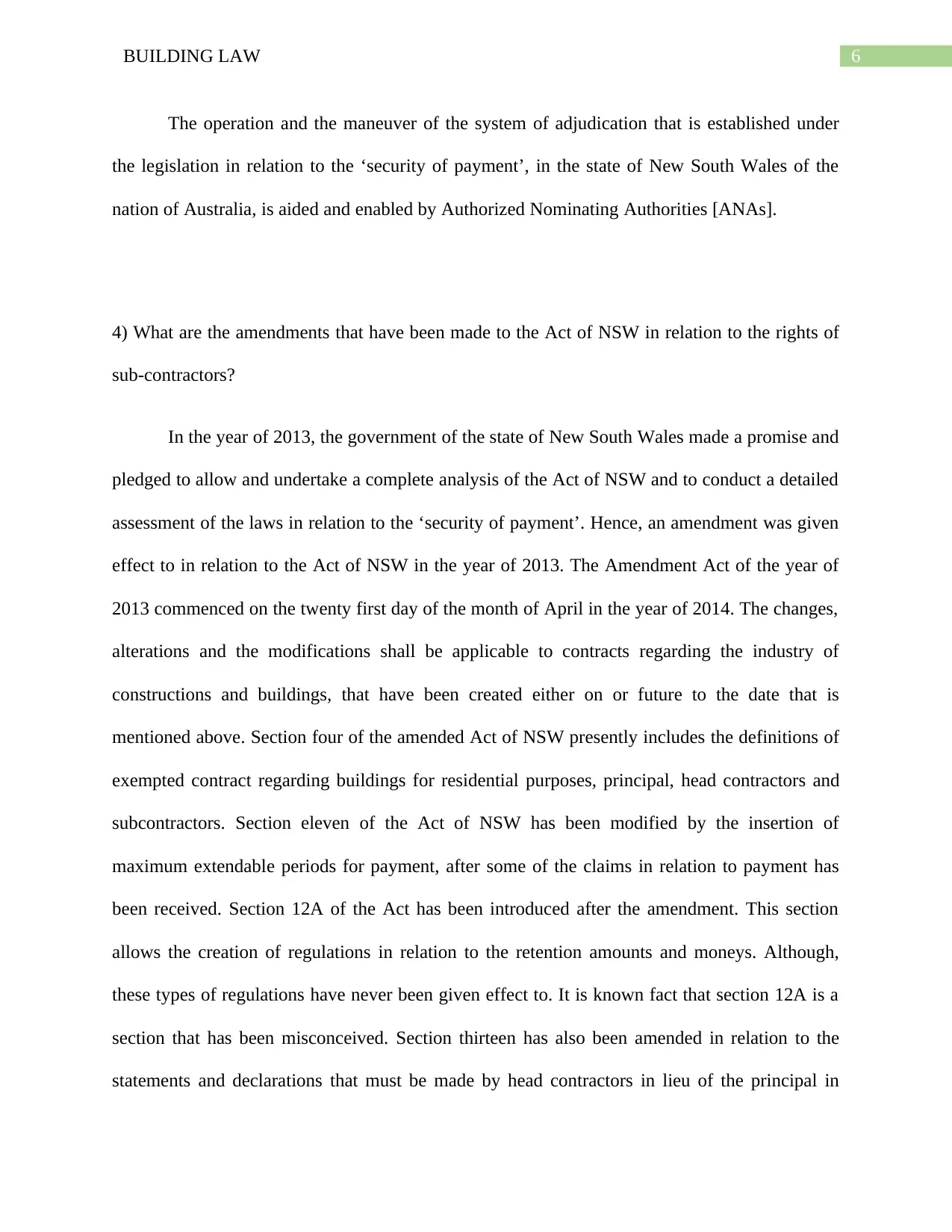
6BUILDING LAW
The operation and the maneuver of the system of adjudication that is established under
the legislation in relation to the ‘security of payment’, in the state of New South Wales of the
nation of Australia, is aided and enabled by Authorized Nominating Authorities [ANAs].
4) What are the amendments that have been made to the Act of NSW in relation to the rights of
sub-contractors?
In the year of 2013, the government of the state of New South Wales made a promise and
pledged to allow and undertake a complete analysis of the Act of NSW and to conduct a detailed
assessment of the laws in relation to the ‘security of payment’. Hence, an amendment was given
effect to in relation to the Act of NSW in the year of 2013. The Amendment Act of the year of
2013 commenced on the twenty first day of the month of April in the year of 2014. The changes,
alterations and the modifications shall be applicable to contracts regarding the industry of
constructions and buildings, that have been created either on or future to the date that is
mentioned above. Section four of the amended Act of NSW presently includes the definitions of
exempted contract regarding buildings for residential purposes, principal, head contractors and
subcontractors. Section eleven of the Act of NSW has been modified by the insertion of
maximum extendable periods for payment, after some of the claims in relation to payment has
been received. Section 12A of the Act has been introduced after the amendment. This section
allows the creation of regulations in relation to the retention amounts and moneys. Although,
these types of regulations have never been given effect to. It is known fact that section 12A is a
section that has been misconceived. Section thirteen has also been amended in relation to the
statements and declarations that must be made by head contractors in lieu of the principal in
The operation and the maneuver of the system of adjudication that is established under
the legislation in relation to the ‘security of payment’, in the state of New South Wales of the
nation of Australia, is aided and enabled by Authorized Nominating Authorities [ANAs].
4) What are the amendments that have been made to the Act of NSW in relation to the rights of
sub-contractors?
In the year of 2013, the government of the state of New South Wales made a promise and
pledged to allow and undertake a complete analysis of the Act of NSW and to conduct a detailed
assessment of the laws in relation to the ‘security of payment’. Hence, an amendment was given
effect to in relation to the Act of NSW in the year of 2013. The Amendment Act of the year of
2013 commenced on the twenty first day of the month of April in the year of 2014. The changes,
alterations and the modifications shall be applicable to contracts regarding the industry of
constructions and buildings, that have been created either on or future to the date that is
mentioned above. Section four of the amended Act of NSW presently includes the definitions of
exempted contract regarding buildings for residential purposes, principal, head contractors and
subcontractors. Section eleven of the Act of NSW has been modified by the insertion of
maximum extendable periods for payment, after some of the claims in relation to payment has
been received. Section 12A of the Act has been introduced after the amendment. This section
allows the creation of regulations in relation to the retention amounts and moneys. Although,
these types of regulations have never been given effect to. It is known fact that section 12A is a
section that has been misconceived. Section thirteen has also been amended in relation to the
statements and declarations that must be made by head contractors in lieu of the principal in
Paraphrase This Document
Need a fresh take? Get an instant paraphrase of this document with our AI Paraphraser
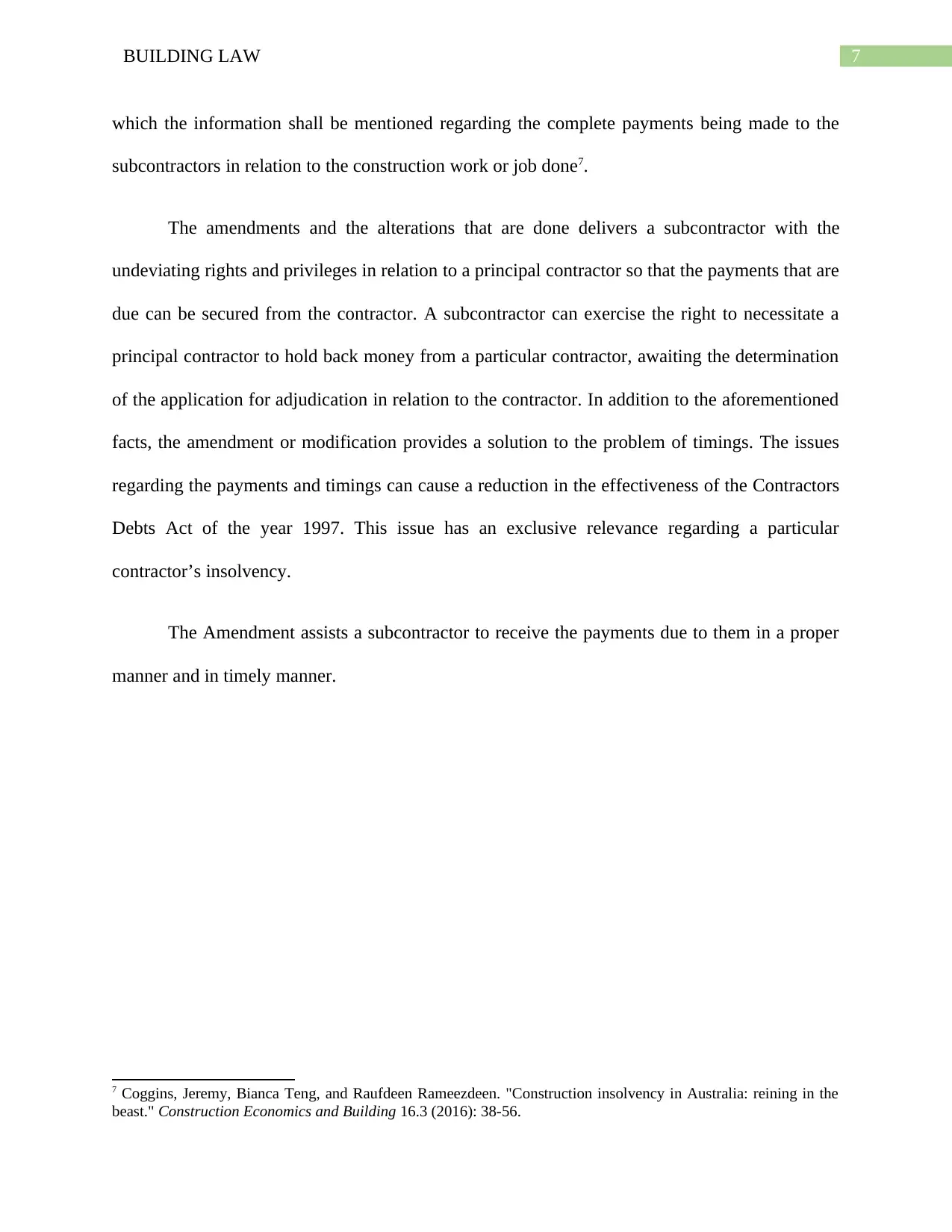
7BUILDING LAW
which the information shall be mentioned regarding the complete payments being made to the
subcontractors in relation to the construction work or job done7.
The amendments and the alterations that are done delivers a subcontractor with the
undeviating rights and privileges in relation to a principal contractor so that the payments that are
due can be secured from the contractor. A subcontractor can exercise the right to necessitate a
principal contractor to hold back money from a particular contractor, awaiting the determination
of the application for adjudication in relation to the contractor. In addition to the aforementioned
facts, the amendment or modification provides a solution to the problem of timings. The issues
regarding the payments and timings can cause a reduction in the effectiveness of the Contractors
Debts Act of the year 1997. This issue has an exclusive relevance regarding a particular
contractor’s insolvency.
The Amendment assists a subcontractor to receive the payments due to them in a proper
manner and in timely manner.
7 Coggins, Jeremy, Bianca Teng, and Raufdeen Rameezdeen. "Construction insolvency in Australia: reining in the
beast." Construction Economics and Building 16.3 (2016): 38-56.
which the information shall be mentioned regarding the complete payments being made to the
subcontractors in relation to the construction work or job done7.
The amendments and the alterations that are done delivers a subcontractor with the
undeviating rights and privileges in relation to a principal contractor so that the payments that are
due can be secured from the contractor. A subcontractor can exercise the right to necessitate a
principal contractor to hold back money from a particular contractor, awaiting the determination
of the application for adjudication in relation to the contractor. In addition to the aforementioned
facts, the amendment or modification provides a solution to the problem of timings. The issues
regarding the payments and timings can cause a reduction in the effectiveness of the Contractors
Debts Act of the year 1997. This issue has an exclusive relevance regarding a particular
contractor’s insolvency.
The Amendment assists a subcontractor to receive the payments due to them in a proper
manner and in timely manner.
7 Coggins, Jeremy, Bianca Teng, and Raufdeen Rameezdeen. "Construction insolvency in Australia: reining in the
beast." Construction Economics and Building 16.3 (2016): 38-56.
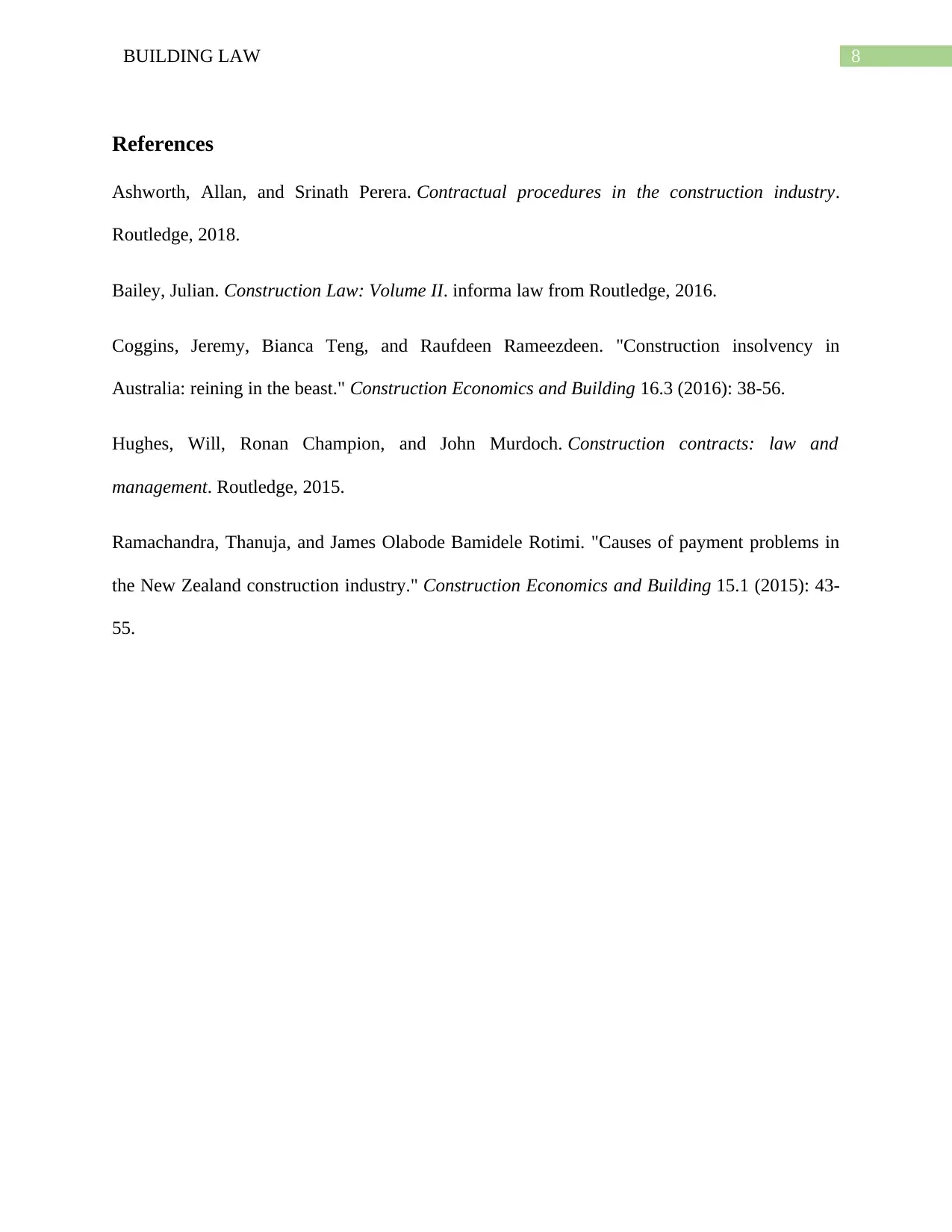
8BUILDING LAW
References
Ashworth, Allan, and Srinath Perera. Contractual procedures in the construction industry.
Routledge, 2018.
Bailey, Julian. Construction Law: Volume II. informa law from Routledge, 2016.
Coggins, Jeremy, Bianca Teng, and Raufdeen Rameezdeen. "Construction insolvency in
Australia: reining in the beast." Construction Economics and Building 16.3 (2016): 38-56.
Hughes, Will, Ronan Champion, and John Murdoch. Construction contracts: law and
management. Routledge, 2015.
Ramachandra, Thanuja, and James Olabode Bamidele Rotimi. "Causes of payment problems in
the New Zealand construction industry." Construction Economics and Building 15.1 (2015): 43-
55.
References
Ashworth, Allan, and Srinath Perera. Contractual procedures in the construction industry.
Routledge, 2018.
Bailey, Julian. Construction Law: Volume II. informa law from Routledge, 2016.
Coggins, Jeremy, Bianca Teng, and Raufdeen Rameezdeen. "Construction insolvency in
Australia: reining in the beast." Construction Economics and Building 16.3 (2016): 38-56.
Hughes, Will, Ronan Champion, and John Murdoch. Construction contracts: law and
management. Routledge, 2015.
Ramachandra, Thanuja, and James Olabode Bamidele Rotimi. "Causes of payment problems in
the New Zealand construction industry." Construction Economics and Building 15.1 (2015): 43-
55.
⊘ This is a preview!⊘
Do you want full access?
Subscribe today to unlock all pages.

Trusted by 1+ million students worldwide
1 out of 9
Related Documents
Your All-in-One AI-Powered Toolkit for Academic Success.
+13062052269
info@desklib.com
Available 24*7 on WhatsApp / Email
![[object Object]](/_next/static/media/star-bottom.7253800d.svg)
Unlock your academic potential
Copyright © 2020–2025 A2Z Services. All Rights Reserved. Developed and managed by ZUCOL.





